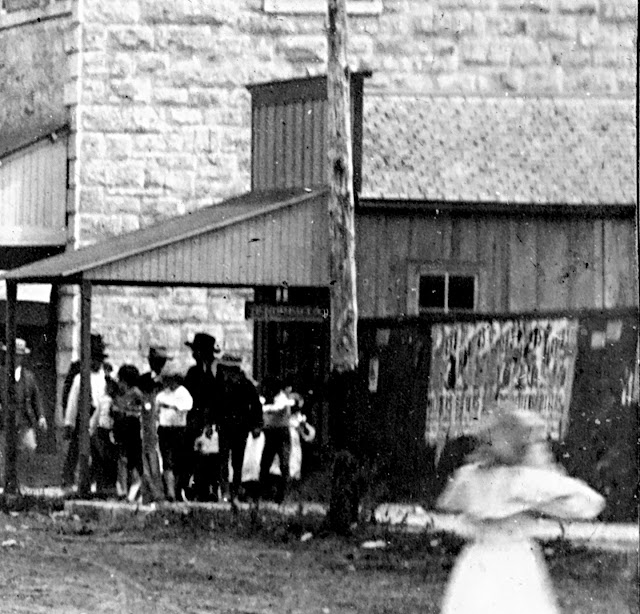 |
Herman Lehmann,
later in life |
Thanks to two kind friends, Clifton Fifer and Paula Reynolds, last week I got to meet a kind woman named Esther, whose father, Wm. "Willie" F. Lehmann, along with her uncle, F. Herman Lehmann, was captured by a band of Apaches in what is now Mason County on May 16, 1870.
Esther's father, Willie, was just 8 years old when captured; his brother, Herman, 10. And while Willie was fortunate to only be held for five days, Herman remained with the Apache for eight years.
I had a hard time wrapping my mind around the fact that a child of a person captured by Apaches during the settlement of our area could still be among us, but Esther (and her sister Gerda, who lives in Kerrville) are both very much alive.
May 16, 1870, the day the boys were captured, was a very long time ago, both in terms of time, but also in terms of history. The world was a very different place then, and this part of Texas was very, very different than what it is today.
Willie was 8 when captured, and 62 when Esther was born; and while a gentleman wouldn't ask Esther's age, let me just say the math works out. I was fortunate enough to have lunch with a woman who knew and lived with men who had once been among the Native American tribes of our area. Esther spent time with her father, of course, but also with her Uncle Herman, who lived with Willie and his family for the last years of his life.
Speaking of her uncle, Esther said "He was my playmate, my best friend. I spent hours and hours with him."
Indeed, the room where Herman spent his final years is still kept in much the same way it was during his life. In his room you'll still find his bed, his rocking chair, arrows he made, plus other historic items, including "iron rocks" which were used to paint the skin, as Esther demonstrated during our visit.
Here's what happened that day in 1870:
Willie and Herman, 8 and 10 years old, were in a field near their home, guarding a crop against crows. A band of eight to ten Apaches (probably Lipans) took the boys; their two sisters escaped capture.
 |
Esther as a child, wearing
clothes from her uncle. |
Four days later the Apache band encountered a patrol of ten African-American cavalry men led by Sgt. Emmanuel Stance, near Kickapoo Springs. (Sgt. Stance received the Medal of Honor for "[g]allantry on scout after Indians" that day, the first African-American regular to be so honored.)
It was not these brave Army regulars who rescued Esther's father, however. In their flight from the soldiers, the Apaches discarded Willie to lighten the load on a horse. Willie found himself alone, almost naked, painted like an Apache, wearing a cap made from the scalp of a calf's head, and more than 100 miles from home.
Kickapoo Springs is near Fort McKavett, about half-way between San Angelo and Menard. That's a long way from nowhere, especially if you're an 8 year old boy, and it's 1870, and there are numerous dangers about.
The resourceful boy followed a creek bed and came across a road and waited. A man on horse came by, and spoke to the boy, but since Willie spoke only German, and the horseman did not, Willie didn't understand that a freighter who spoke German was coming along soon. The freighter picked up the boy and took him as far as Kickapoo Springs, where he stayed with a German family who had a boy about his age; the freighter promised to take the boy home on his return.
Willie was gone from home about nine days. Herman was not so fortunate; he was gone more than eight years.
His mother, Augusta Lehmann Buchmeier, never gave up hope, and for years asked the guests at her inn in Loyal Valley if they had seen a blue-eyed boy among the Apaches. For years the answer was no. But when she asked Ranald S. Mackenzie, who commanded Fort Sill, he replied yes.
According to the account in Wikipedia, "in April 1878, Lt. Col. John W. Davidson ordered that Lehmann be sent under guard to his family in Texas. Five soldiers and a driver escorted Lehmann on a four-mule-drawn ambulance to Loyal Valley in Mason County, Texas. Lehmann arrived in Loyal Valley with an escort of soldiers on May 12, 1878, eight years after his capture."
Esther says the guard was necessary: "Uncle Herman was an Indian. He would have made every attempt to escape. He believed his family was dead."
At first Herman Lehmann was not recognized by his family, but when a sister noticed a scar on his hand -- a scar she herself had caused years earlier -- the family knew this was their missing Herman.
Herman didn't recognize his mother at first, but when he saw Willie and a sister (Mina), "the dark curtain of oblivion...was pulled back."
The story of Herman's life among the Indians and his restoration to his family fills several books, including one edited by J. Marvin Hunter, the father of the man from whom my family bought our print shop. There's a chance
Wolfmueller's Books has a copy. It's a very interesting tale.
Until next week, all the best.
This column originally appeared in the Kerrville Daily Times January 28, 2012. Joe Herring's book is on sale now: click here for more information




















































